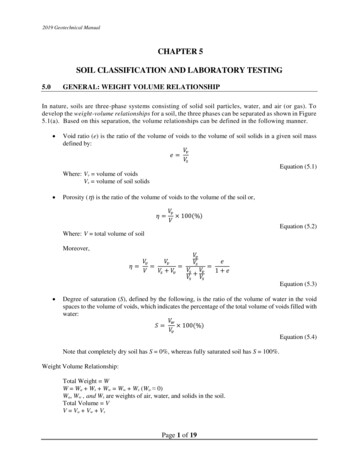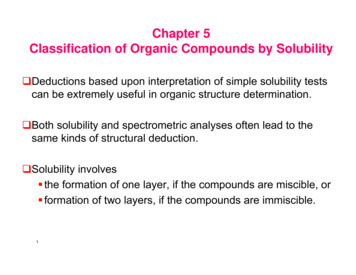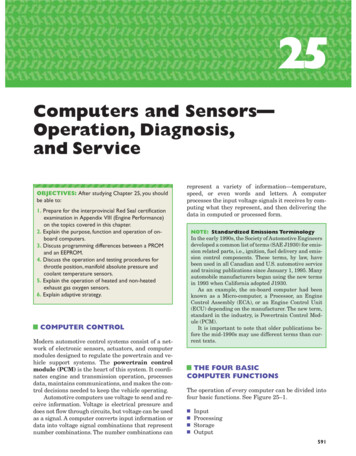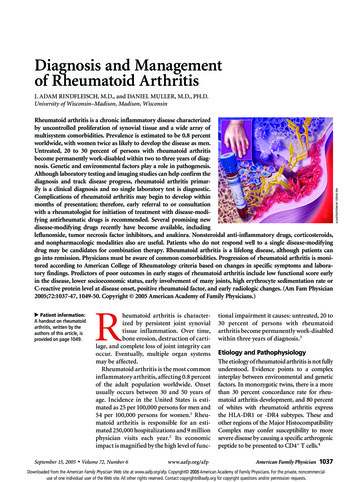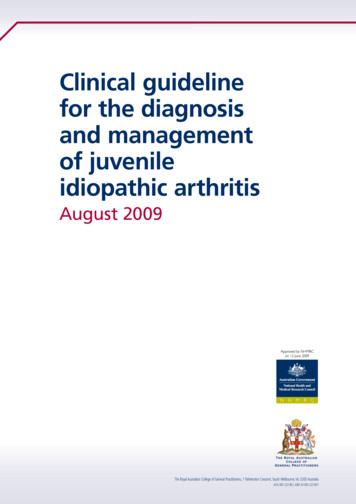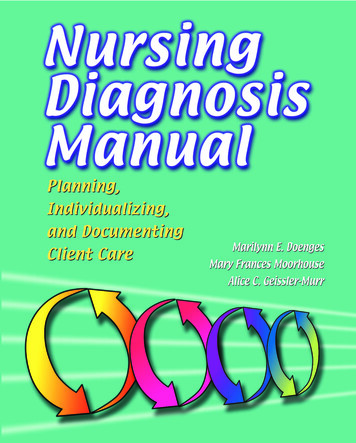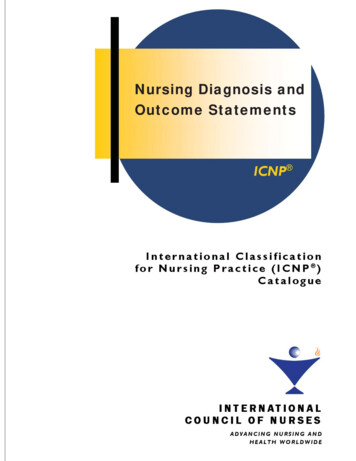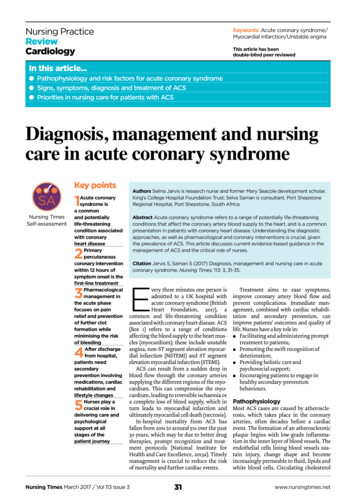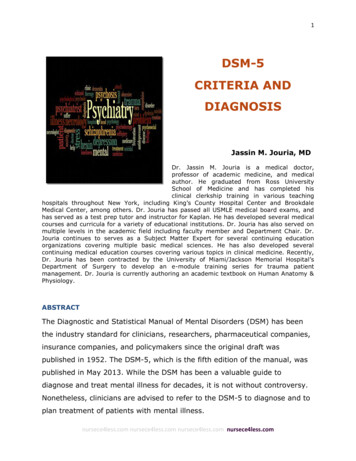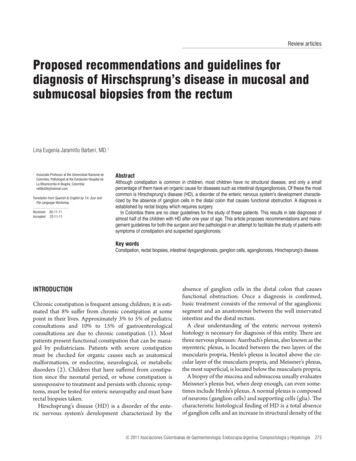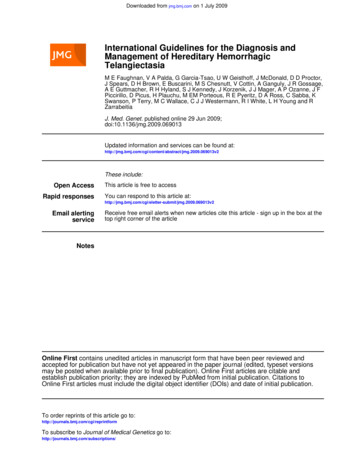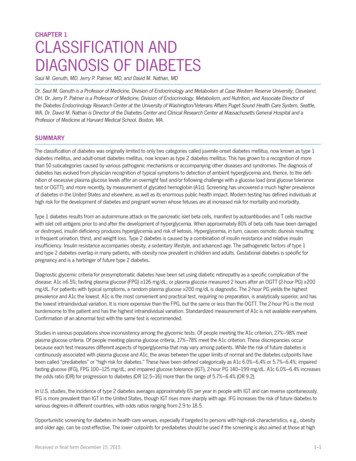
Transcription
CHAPTER 1CLASSIFICATION ANDDIAGNOSIS OF DIABETESSaul M. Genuth, MD, Jerry P. Palmer, MD, and David M. Nathan, MDDr. Saul M. Genuth is a Professor of Medicine, Division of Endocrinology and Metabolism at Case Western Reserve University, Cleveland,OH. Dr. Jerry P. Palmer is a Professor of Medicine, Division of Endocrinology, Metabolism, and Nutrition, and Associate Director ofthe Diabetes Endocrinology Research Center at the University of Washington/Veterans Affairs Puget Sound Health Care System, Seattle,WA. Dr. David M. Nathan is Director of the Diabetes Center and Clinical Research Center at Massachusetts General Hospital and aProfessor of Medicine at Harvard Medical School, Boston, MA.SUMMARYThe classification of diabetes was originally limited to only two categories called juvenile-onset diabetes mellitus, now known as type 1diabetes mellitus, and adult-onset diabetes mellitus, now known as type 2 diabetes mellitus. This has grown to a recognition of morethan 50 subcategories caused by various pathogenic mechanisms or accompanying other diseases and syndromes. The diagnosis ofdiabetes has evolved from physician recognition of typical symptoms to detection of ambient hyperglycemia and, thence, to the definition of excessive plasma glucose levels after an overnight fast and/or following challenge with a glucose load (oral glucose tolerancetest or OGTT), and more recently, by measurement of glycated hemoglobin (A1c). Screening has uncovered a much higher prevalenceof diabetes in the United States and elsewhere, as well as its enormous public health impact. Modern testing has defined individuals athigh risk for the development of diabetes and pregnant women whose fetuses are at increased risk for mortality and morbidity.Type 1 diabetes results from an autoimmune attack on the pancreatic islet beta cells, manifest by autoantibodies and T cells reactivewith islet cell antigens prior to and after the development of hyperglycemia. When approximately 80% of beta cells have been damagedor destroyed, insulin deficiency produces hyperglycemia and risk of ketosis. Hyperglycemia, in turn, causes osmotic diuresis resultingin frequent urination, thirst, and weight loss. Type 2 diabetes is caused by a combination of insulin resistance and relative insulininsufficiency. Insulin resistance accompanies obesity, a sedentary lifestyle, and advanced age. The pathogenetic factors of type 1and type 2 diabetes overlap in many patients, with obesity now prevalent in children and adults. Gestational diabetes is specific forpregnancy and is a harbinger of future type 2 diabetes.Diagnostic glycemic criteria for presymptomatic diabetes have been set using diabetic retinopathy as a specific complication of thedisease: A1c 6.5%; fasting plasma glucose (FPG) 126 mg/dL; or plasma glucose measured 2 hours after an OGTT (2-hour PG) 200mg/dL. For patients with typical symptoms, a random plasma glucose 200 mg/dL is diagnostic. The 2-hour PG yields the highestprevalence and A1c the lowest. A1c is the most convenient and practical test, requiring no preparation, is analytically superior, and hasthe lowest intraindividual variation. It is more expensive than the FPG, but the same or less than the OGTT. The 2-hour PG is the mostburdensome to the patient and has the highest intraindividual variation. Standardized measurement of A1c is not available everywhere.Confirmation of an abnormal test with the same test is recommended.Studies in various populations show inconsistency among the glycemic tests. Of people meeting the A1c criterion, 27%–98% meetplasma glucose criteria. Of people meeting plasma glucose criteria, 17%–78% meet the A1c criterion. These discrepancies occurbecause each test measures different aspects of hyperglycemia that may vary among patients. While the risk of future diabetes iscontinuously associated with plasma glucose and A1c, the areas between the upper limits of normal and the diabetes cutpoints havebeen called “prediabetes” or “high risk for diabetes.” These have been defined categorically as A1c 6.0%–6.4% or 5.7%–6.4%; impairedfasting glucose (IFG), FPG 100–125 mg/dL; and impaired glucose tolerance (IGT), 2-hour PG 140–199 mg/dL. A1c 6.0%–6.4% increasesthe odds ratio (OR) for progression to diabetes (OR 12.5–16) more than the range of 5.7%–6.4% (OR 9.2).In U.S. studies, the incidence of type 2 diabetes averages approximately 6% per year in people with IGT and can reverse spontaneously.IFG is more prevalent than IGT in the United States, though IGT rises more sharply with age. IFG increases the risk of future diabetes tovarious degrees in different countries, with odds ratios ranging from 2.9 to 18.5.Opportunistic screening for diabetes in health care venues, especially if targeted to persons with high-risk characteristics, e.g., obesityand older age, can be cost-effective. The lower cutpoints for prediabetes should be used if the screening is also aimed at those at highReceived in final form December 15, 2015.1–1
DIABETES IN AMERICA, 3rd Editionrisk for developing diabetes. Indiscriminate public screening for diabetes is not yet supported by sufficient long-term benefit gained fromearly detection of asymptomatic diabetes, nor has its cost-effectiveness been demonstrated. However, if undertaken, a capillary bloodglucose 120 mg/dL is an efficient screening cutpoint with relatively low cost per case detected.The major public health implication of diagnosing asymptomatic diabetes is that diabetes is a major cause of cardiovascular disease,renal failure requiring dialysis and kidney transplant, and blindness or vision-threatening retinal disease necessitating surgery or intraocular injection therapy. With appropriate targeted therapy of hyperglycemia, hypertension, and dyslipidemia, these complications can beprevented or ameliorated.INTRODUCTIONDiabetes is a complex metabolic disorderconsisting of two main types: type 1,comprising approximately 5% of diabetes,and type 2, comprising 90%–95% (1).The prevalence of diabetes, especiallytype 2 diabetes, is rising in the UnitedStates, associated with increasedprevalence of obesity, vulnerableminorities, and aging, in the setting ofpolygenic risk. While the annual incidencein the United States may have plateauedin recent years, the epidemic of diabetesand its risk factors occur worldwide (2,3,4).Although carbohydrate metabolism ismost obviously deranged and is the basisfor biochemical tests of the diagnosis, fatmetabolism is also adversely affected,and abnormalities in protein metabolism,though more subtle, also exist. Forexample, fasting free fatty acid andtriglyceride levels are elevated, and tissueuptake of amino acids, especially branchchain amino acids, in response to insulinis impaired.The derangements in carbohydratemetabolism that characterize diabetes areclinically recognizable by patients whenplasma glucose elevations reach levelsthat cause glycosuria and polyuria withresultant polydipsia. These symptoms maynot occur early in type 2 diabetes owing tothe slow, progressive rise in glycemia overtime, and when present, they generallyare relieved by nutritional and pharmacological therapy. By contrast, the onsetof type 1 diabetes is clinically abrupt andusually requires immediate initiation ofinsulin therapy. In both types, hyperglycemia causes the later development of“diabetic complications,” the morbidityand mortality of which dominate the clinical picture and fate of diabetic individuals,as well as the economic costs of diabetesin the United States, which amounted to 245 billion in 2012 (5).While the clinical recognition of diabeteshas existed for many centuries, itslinkage to high levels of glucose in theblood and urine is more recent and haspermitted development of increasinglysophisticated tests for the disease.Excessive levels of glucose now reliablyidentify individuals at risk for the seriousand lethal complications of diabetes. Thishas placed a premium on glucose-baseddiagnostic tests with cutpoints that predictan increased risk of retinopathy, the mostspecific of the diabetic complications.This chapter is composed of two mainsections. The first section presentsan updated classification of diabeteswith numerous subtypes that arecharacterized by their clinical contexts,phenotypes, variable clinical courses,and pathophysiologies. A category of“prediabetes” or “high risk for diabetes,”better defined for type 2 diabetes than fortype 1 diabetes, has been added to theclassification as well.The second major section deals with thediagnosis of and screening for diabetes.The most recent test, measurement ofglycated hemoglobin (A1c), is popularfor its practicality, reflection of glycemiafor months rather than hours, andanalytical precision. An A1c level 6.5%( 48 mmol/mol) is recognized by theAmerican Diabetes Association (ADA),an International Expert Committee(IEC), and the World Health Organizationas diagnostic for diabetes. Criteriafor diagnosis using plasma glucosemeasured in the fasting state ( 126mg/dL [6.99 mmol/L]) and 2 hoursafter an oral glucose load ( 200 mg/dL[ 11.10 mmol/L]) are also presented andcompared with the A1c criterion withregard to sensitivity and specificity fordetecting diabetes. The criteria definingthe category “high risk for diabetes” varysomewhat among the promulgatinggroups.Screening for previously unknowndiabetes in both health care venues andpublic venues is presented using thevarious tests. The potential benefits andrisks of screening are discussed.CLASSIFICATION OF DIABETESDiabetes is not a single disease but rathera syndrome characterized by hyperglycemia, and over time, by increased risk ofdamage to eyes, kidneys, and nerves and,less specifically, to heart and medium andlarge caliber blood vessels. Diabetes canbe divided into four major types: type 1,1–2type 2, gestational, and secondary orother specific types of diabetes (6). Thevast majority of patients comprise thefirst two types, and over the years, manyother names have been used, includingjuvenile-onset/adult-onset, ketosis-prone/non-ketosis-prone, and insulin-dependent/non-insulin-dependent. All of thesenames imply phenotypic features that areproblematic for categorizing the type ofdiabetes in individual patients, and consequently, the preferred nomenclature isnow type 1 diabetes and type 2 diabetes.Gestational diabetes applies to diabetes
Classification and Diagnosis of Diabetesdiagnosed during pregnancy. Secondaryor other specific types of diabetes encompass a large spectrum of specific causes,including monogenic defects of beta cellfunction, genetic defects in insulin actionor structure, pancreatic diseases such aspancreatitis and hemochromatosis, endocrinopathies, drug/chemical and surgicallyinduced, infections, and uncommonimmune-mediated and other geneticsyndromes sometimes associated withdiabetes. Detailed discussions of eachtype of diabetes are provided in Section ISpectrum of Diabetes, Chapters 2–7.studies in which subjects at high risk fortype 1 diabetes are followed very closely,over 50% of cases are diagnosed withhyperglycemia that is asymptomatic sincethe glucose levels are not high enough tocause symptoms, such as polyuria andweight loss (8,9). This is very differentthan the seemingly abrupt onset ofsymptoms when people are diagnosed inthe clinical setting.TYPE 1 DIABETESType 1 diabetes represents approximately5% of all diabetes (1). Central to thepathophysiology of most cases of type 1diabetes is an autoimmune attack on thepancreatic beta cells resulting in severeinsulin deficiency. Although the beta celldamage and death are primarily T cellmediated, B cell-formed autoantibodiesto islet antigens are used as markers ofthe disease and may play a pathogenicrole. Research studies frequently requirepositivity for one or more of theseautoantibodies for the diagnosis of type 1diabetes. There also may be nonimmunemediated causes of beta cell damage anddestruction and, especially in Asians, adisease called fulminant diabetes hasbeen described (7).Although severe insulin deficiency is acentral element of type 1 diabetes, it maynot discriminate between type 1 diabetes,especially early in its course, and type2 diabetes, especially late in its course.Insulin and C-peptide levels may not beseverely low early in the type 1 diseaseprocess and during the “honeymoonperiod,” a time shortly after diabetesdiagnosis when diabetes appears to goaway for a period of a few months toa year. Conversely, some patients withtype 2 diabetes may have severe insulindeficiency with very low insulin andC-peptide levels later in its course thatoverlap the levels in type 1 diabetes. Thebest laboratory tests to differentiate type 1from type 2 diabetes are autoantibodies toglutamic acid decarboxylase (GAD), insulin,insulinoma-associated protein 2 (IA-2), andzinc transporter 8 (ZnT8), especially whenpatients are positive for more than oneand have relatively high titers.At the time of diagnosis, type 1 diabetespatients are typically of peripubertalage, Caucasian, lean, and with a shortduration of symptoms, such as polyuria,polydipsia, and weight loss. A familyhistory of type 1 diabetes is oftenabsent, although a family history of otherautoimmune disease, such as Grave’sdisease or Hashimoto’s thyroiditis, may bepresent. No single clinical characteristic,such as age at diagnosis, body mass, oreven ketoacidosis, is sufficiently sensitiveand specific for type 1 diabetes to bevery useful in distinguishing one form ofdiabetes from another. For example, withthe increasing epidemic of childhood andadolescent obesity, children with type1 diabetes reflect the usual distributionof weight in their age group. In type 1diabetes prevention and natural historyType 1 diabetes is heterogeneous in anumber of respects. Although severalgenes predisposing to and protectingfrom type 1 diabetes are well described,genotypes of individual patients spana large spectrum. Many environmentalfactors may trigger and/or influence theseverity of the autoimmune
diabetes mellitus, and adult-onset diabetes mellitus, now known as type 2 diabetes mellitus. This has grown to a recognition of more than 50 subcategories caused by various pathogenic mechanisms or accompanying other diseases and syndromes. The diagnosis of diabetes has evolved from physician recognition of typical symptoms to detection of ambient hyperglycemia and, thence, to

